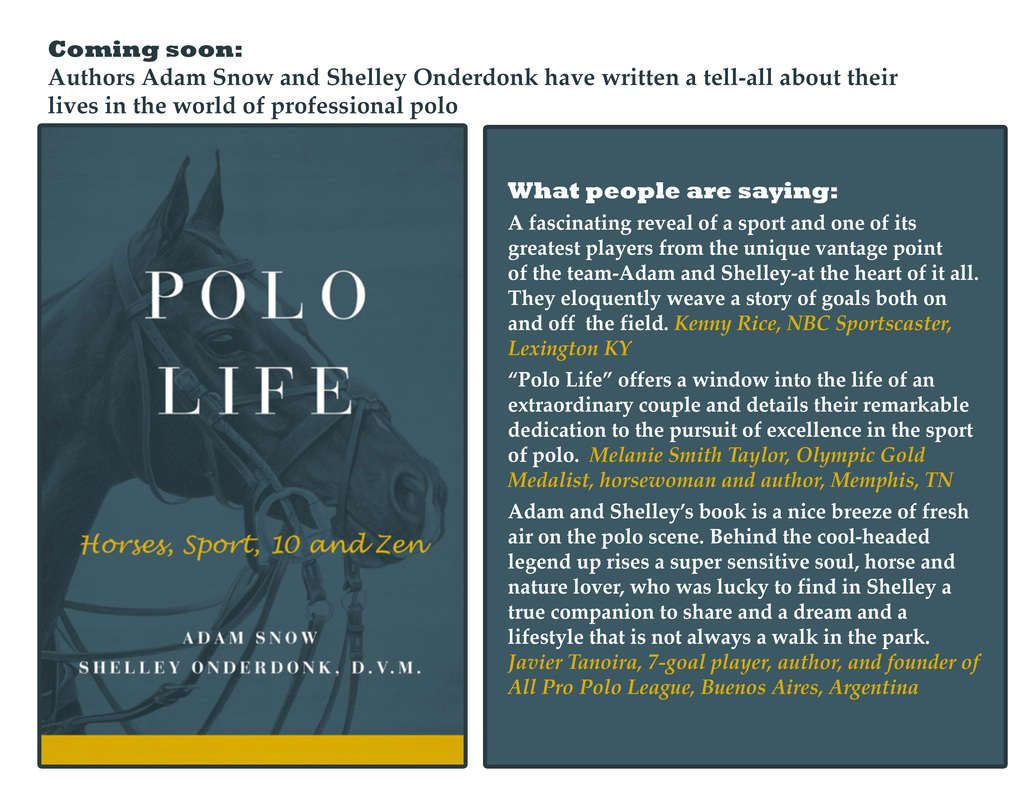available on Amazon and pololife.co/
|
Polo Life: Horses, Sport, 10 and Zen delves into the world of high goal polo through the uniquely situated lenses of former 10-goaler Adam Snow and his wife and veterinarian, Shelley Onderdonk. Together their voices provide unprecedented access into the horse and human dynamics that make the sport tick; their passion, respect, and commitment for the sport and each other shine through each page. Less polo manual than human interest story, their chapters cover a broad range of topics: there is a horse so good she probably single-handedly altered the trajectory of Adam’s career, a farm named after the city where the couple met in college, and a country and polo culture that shaped Adam as a player...and where their luggage was stolen more than once. Adam recounts his childhood obsession with ball sports; Shelley hers with horses. Together, they reveal how sports psychology has been integral to Adam’s success, tell behind-the-scenes stories about teammates, grooms and trainers, celebrate their legendary equine partners, and provide an uncensored glimpse into the glamorous international component of the sport from Buenos Aires to Bandar Seri Begawan. The dynamics of maintaining a healthy marriage and family within the framework of a professional athlete’s career are also fundamental to Adam and Shelley’s polo life. Their prose—by turns humble, humorous, and inspirational—showcases the sport’s enduring appeal.
Whether you are riding, feeding or turning out your horse it makes sense to think about your goals and work backwards from there. A good turnout experience can be incredibly healthful for your horse if done well. It can also be a disaster if unsafe fencing, poor shelter or inexperienced personnel put your horses well-being at risk. It is worth taking some time to think about the reason your horse needs turnout, and putting some money towards making the most of the time. Some common goals of turnout are:
1. physiological rest 2. mental rest from stresses of travel/competition/stabling 3. socialization eg "learning" from other horses and relaxation 4. physical rehabilitation, from clinical or subclinical injury, 5. weight gain, maintenance or loss, measured by BCS (body condition score) So depending on which of the above factors are relevant to your horse will determine the type of turnout you need. Factors include size of field, terrain of field, quality/type of grass, length of time, which and how many other horses they will be with, and amount of contact with humans. Ideally, you can assess your horses individual needs and find a turnout situation that meets them. You will have a happy and healthy horse in a few months ready to get started back to work. I.C.E. is the standard acronym applied to human physical therapy. In horses, Ice and Compression are also very important. Elevation in the horse is quite impossible, however, so adding Rest is crucial. My general algorithm for minor injuries:
1. Ice for first 3 days, two to three times a day for 10 minutes 2. Wrap area 3. Back off of intensity of work for 3 days. Ideally still walk 45-60 minutes daily to maintain muscle mass, and turn-out to maintain mental calm 4. Adjust feeding schedule to reduce grain/increase forage if applicable The basis of fitness for the polo pony is long slow distance work (LSD). After a period of turn-out, gradually increasing distance and speed over a course of 4-6 weeks allows time for the bones, muscles and cardiovascular system to accommodate exercise. However, in any group of horses, individual requirements will vary according to age, history of injuries, intended use, stabling situation, level of training, and incoming body condition score (BCS).
Typically, in legging-up mature trained horses who have access to turn-out, and are injury-free, I recommend starting with walking 1 hour for the first week. During weeks 2-4 trotting is added in the middle of the set in increments of 2-3 minutes until they are ideally doing a walk 25/trot 20/walk 25 set daily.This completes their LSD preparation, and may take longer or shorter time depending on circumstances. Weeks 5 and 6 consist of starting to single the horse, which ideally should be a "chukker without a mallet," attempting to reproduce as much as possible what the horse will be asked to do when played in a game. Attention should be paid to straightness and symmetry, as well as changes of pace and direction. When the horse is able to gallop and turn thus for 5 minutes without blowing too hard then easy chukkers are introduced. Generally after 3 or 4 practice chukkers the horse is ready to play. Once a polo pony is fit, they need very little cardiovascular work to maintain fitness. For example, if they are playing twice a week, most ponies do well with the remainder of exercise being LSD sets. The goal shifts to minimizing wear and tear--this is where LSD is so beneficial in maintaining strength and suppleness without overstressing the joints or overtaxing the physiological system. |
Archives |

